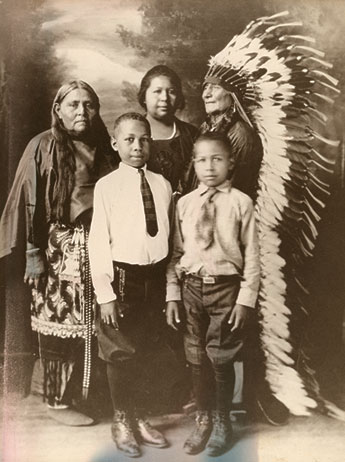This content was published: November 27, 2013. Phone numbers, email addresses, and other information may have changed.
National Museum of the American Indian’s ‘IndiVisible’ exhibit on display
Photos and story by Abe Proctor

Comanche family, early 1900s. Back row, from left: Ta-Tat-ty, also known as Qu-vuh-tu; Wife-per, or Frances E. Wright; Ta-Ten-e-quer. Front row: Henry (left) and Lorenzano, also called Moots. Courtesy Sam DeVenney.
Within the fabric of American identity is woven a story that has long been invisible — the lives and experiences of people who share both African American and Native American ancestry. Addressing more than 500 years of history and the challenge of American society’s entrenched racial categories, the National Museum of the American Indian’s traveling exhibit “IndiVisible: African-Native American Lives in the Americas” is on display now at Cascade Campus Library. “IndiVisible” will remain on display through Thursday, Jan. 23.
An reception and presentation on the exhibit will be held from 3 to 5 p.m. Friday, Jan. 10, in the Cascade Library, 705 N. Killingsworth St.
Propelled by the twin forces of slavery and colonialism, African and Native peoples came together in the Americas. Over the centuries, African Americans and Native Americans created shared histories, communities, families, and ways of life. Faced with centuries of government policies and laws that systematically oppressed and excluded them, African-Native Americans came together to find creative and effective ways to fight against slavery and dispossession, and then for self-determination and freedom – and to express their distinct cultural syntheses.
“IndiVisible,” a multidisciplinary exhibit, addresses this history, governmental policy, sociology, anthropology, art, music, and literature from the 15th century to the present. The exhibit is a collaboration between the Smithsonian’s National Museum of the American Indian, National Museum of African American History and Culture, and the Smithsonian Institution Travelling Exhibition Service (SITES).
